Instruction
How to Maintain Great Posture in Your Golf Swing

Golf is a rotational sport similar to other sports like baseball and hockey, which means we generate a lot of our speed from the turning of our bodies in our golf swing. So having the ability to turn your body is a huge advantage when trying to generate club head speed. One of the main differences between great ball strikers like Sergio Garcia and golfers that struggle to hit the ball consistently, however, is that the great ball strikers manage to maintain their great posture in their golf swings. Golfers that are struggling… they usually don’t.
The facts are that a lot of golfers that I work with on a daily basis struggle to hit the ball consistently, and one of the main reasons is that they lose their posture at some point in their golf swing. A lot of them are almost standing up as they are making their backswing, and others are standing up through impact as their hips move closer to the ball with their torso and head straightening up in order to maintain balance and not fall forward. When this happens, they lose both their posture and the ability to hit the ball with any kind of authority.
If this sounds like you, or perhaps someone you know, then your body will be turning from a too upright position that might work really great if you were playing baseball. But this is not baseball, it is golf, where the ball is played from the ground and not waist height. So to gain more consistency and perhaps add more yardage to your shots, you need to learn how to maintain your posture while turning your body in your golf swing.
This is done by doing two things. The first is having a great posture at your setup, and the second is learning how to maintain that great posture by doing something called side bend while making your golf swing.
So let’s start by working on attaining great posture. The thing about great posture is that it can be slightly challenging for a lot of golfers to attain. This is usually due to muscle imbalances that can prevent setting up to the ball properly. Now I know you may be thinking, “Muscle imbalances, not me. When I was in college I used to be the best lawn bowler on the team…” or whatever sport you played. But the facts are that muscle imbalances are often due to our lifestyles and quite usually not felt on a daily basis. So you most likely don’t even know that you have any imbalances, even if you do.
If you are serious about your golf, and I know you are, then it would be a great idea to get yourself screened from a TPI certified expert. Or if you don’t have an expert in your area, then there are some self-screening tests and exercises that will assist you in my first book, the Golfers Handbook.
In this first video, I demonstrate an exercise that will help you learn good posture. If done regularly, it can actually be used as a correctional exercise that will help you loosen up some of the those muscle imbalances so that you can attain great posture.
Now that you’ve gained great posture at your setup, you need to learn how to maintain it while turning your body in your swing. This is done by gaining side bend. I explain what side bend is in the next video and demonstrate how you can learn to maintain it by doing some warm up exercises.
By creating great posture and learning how to maintain it with side bend in your golf swing, you too will be on your way to becoming a great ball striker.
- LIKE135
- LEGIT11
- WOW9
- LOL4
- IDHT1
- FLOP6
- OB2
- SHANK54
Instruction
The Wedge Guy: The easiest-to-learn golf basic

My golf learning began with this simple fact – if you don’t have a fundamentally sound hold on the golf club, it is practically impossible for your body to execute a fundamentally sound golf swing. I’m still a big believer that the golf swing is much easier to execute if you begin with the proper hold on the club.
As you might imagine, I come into contact with hundreds of golfers of all skill levels. And it is very rare to see a good player with a bad hold on the golf club. There are some exceptions, for sure, but they are very few and very far between, and they typically have beat so many balls with their poor grip that they’ve found a way to work around it.
The reality of biophysics is that the body moves only in certain ways – and the particulars of the way you hold the golf club can totally prevent a sound swing motion that allows the club to release properly through the impact zone. The wonderful thing is that anyone can learn how to put a fundamentally sound hold on the golf club, and you can practice it anywhere your hands are not otherwise engaged, like watching TV or just sitting and relaxing.
Whether you prefer an overlap, interlock or full-finger (not baseball!) grip on the club, the same fundamentals apply. Here are the major grip faults I see most often, in the order of the frequency:
Mis-aligned hands
By this I mean that the palms of the two hands are not parallel to each other. Too many golfers have a weak left hand and strong right, or vice versa. The easiest way to learn how to hold the club with your palms aligned properly is to grip a plain wooden ruler or yardstick. It forces the hands to align properly and shows you how that feels. If you grip and re-grip a yardstick several times, then grip a club, you’ll see that the learning curve is almost immediate.
The position of the grip in the upper/left hand
I also observe many golfers who have the butt of the grip too far into the heel pad of the upper hand (the left hand for right-handed players). It’s amazing how much easier it is to release the club through the ball if even 1/4-1/2″ of the butt is beyond the left heel pad. Try this yourself to see what I mean. Swing the club freely with just your left hand and notice the difference in its release from when you hold it at the end of the grip, versus gripping down even a half inch.
To help you really understand how this works, go to the range and hit shots with your five-iron gripped down a full inch to make the club the same length as your seven-iron. You will probably see an amazing shot shape difference, and likely not see as much distance loss as you would expect.
Too much lower (right) hand on the club
It seems like almost all golfers of 8-10 handicap or higher have the club too far into the palm of the lower hand, because that feels “good” if you are trying to control the path of the clubhead to the ball. But the golf swing is not an effort to hit at the ball – it is a swing of the club. The proper hold on the club has the grip underneath the pad at the base of the fingers. This will likely feel “weak” to you — like you cannot control the club like that. EXACTLY. You should not be trying to control the club with your lower/master hand.
Gripping too tightly
Nearly all golfers hold the club too tightly, which tenses up the forearms and prevents a proper release of the club through impact. In order for the club to move back and through properly, you must feel that the club is controlled by the last three fingers of the upper hand, and the middle two fingers of the lower hand. If you engage your thumbs and forefingers in “holding” the club, the result will almost always be a grip that is too tight. Try this for yourself. Hold the club in your upper hand only, and squeeze firmly with just the last three fingers, with the forefinger and thumb off the club entirely. You have good control, but your forearms are not tense. Then begin to squeeze down with your thumb and forefinger and observe the tensing of the entire forearm. This is the way we are made, so the key to preventing tenseness in the arms is to hold the club very lightly with the “pinchers” — the thumbs and forefingers.
So, those are what I believe are the four fundamentals of a good grip. Anyone can learn them in their home or office very quickly. There is no easier way to improve your ball striking consistency and add distance than giving more attention to the way you hold the golf club.
More from the Wedge Guy
- The Wedge Guy: Golf mastery begins with your wedge game
- The Wedge Guy: Why golf is 20 times harder than brain surgery
- The Wedge Guy: Musings on the golf ball rollback
- LIKE85
- LEGIT13
- WOW6
- LOL1
- IDHT0
- FLOP4
- OB1
- SHANK8
Instruction
Clement: Stop ripping off your swing with this drill!

Not the dreaded headcover under the armpit drill! As if your body is defective and can’t function by itself! Have you seen how incredible the human machine is with all the incredible feats of agility all kinds of athletes are accomplishing? You think your body is so defective (the good Lord is laughing his head off at you) that it needs a headcover tucked under the armpit so you can swing like T-Rex?
- LIKE0
- LEGIT2
- WOW2
- LOL0
- IDHT0
- FLOP0
- OB0
- SHANK2
Instruction
How a towel can fix your golf swing
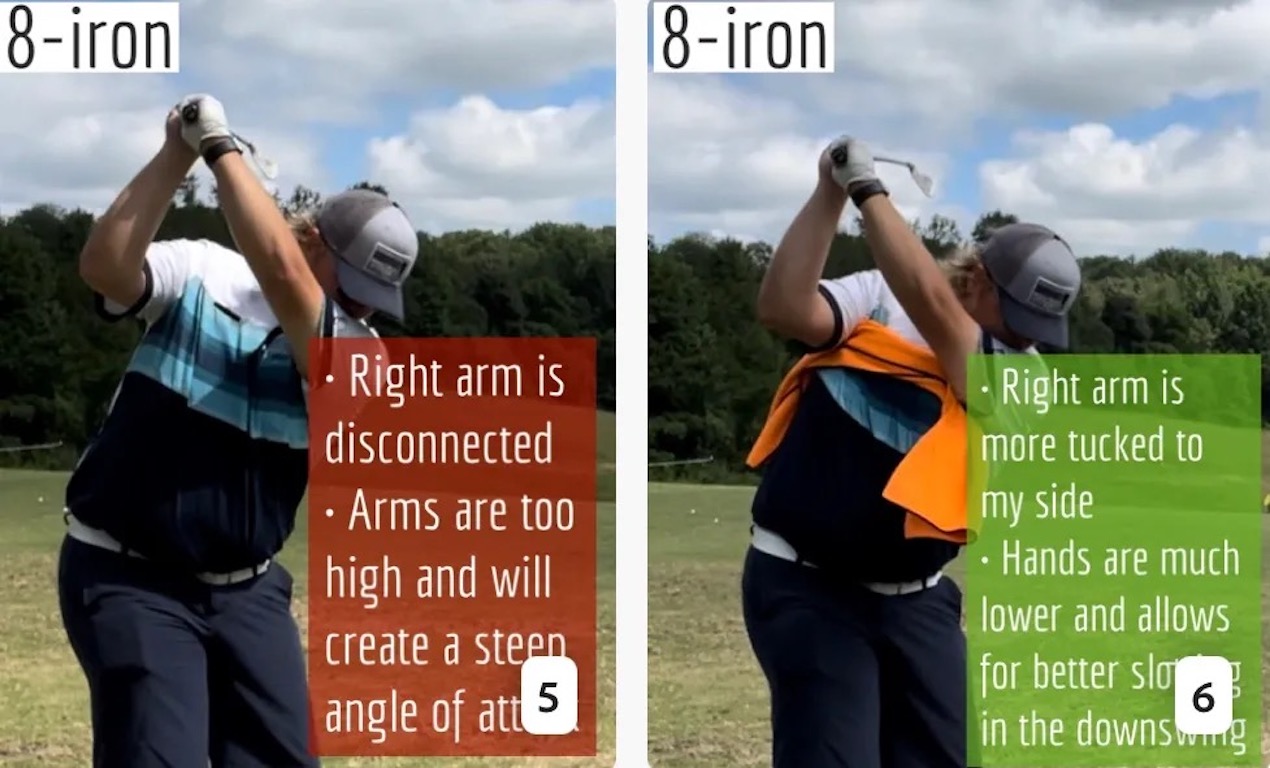
This is a classic drill that has been used for decades. However, the world of marketed training aids has grown so much during that time that this simple practice has been virtually forgotten. Because why teach people how to play golf using everyday items when you can create and sell a product that reinforces the same thing? Nevertheless, I am here to give you helpful advice without running to the nearest Edwin Watts or adding something to your Amazon cart.
For the “scoring clubs,” having a solid connection between the arms and body during the swing, especially through impact, is paramount to creating long-lasting consistency. And keeping that connection throughout the swing helps rotate the shoulders more to generate more power to help you hit it farther. So, how does this drill work, and what will your game benefit from it? Well, let’s get into it.
Setup
You can use this for basic chip shots up to complete swings. I use this with every club in my bag, up to a 9 or 8-iron. It’s natural to create incrementally more separation between the arms and body as you progress up the set. So doing this with a high iron or a wood is not recommended.
While you set up to hit a ball, simply tuck the towel underneath both armpits. The length of the towel will determine how tight it will be across your chest but don’t make it so loose that it gets in the way of your vision. After both sides are tucked, make some focused swings, keeping both arms firmly connected to the body during the backswing and follow through. (Note: It’s normal to lose connection on your lead arm during your finishing pose.) When you’re ready, put a ball in the way of those swings and get to work.
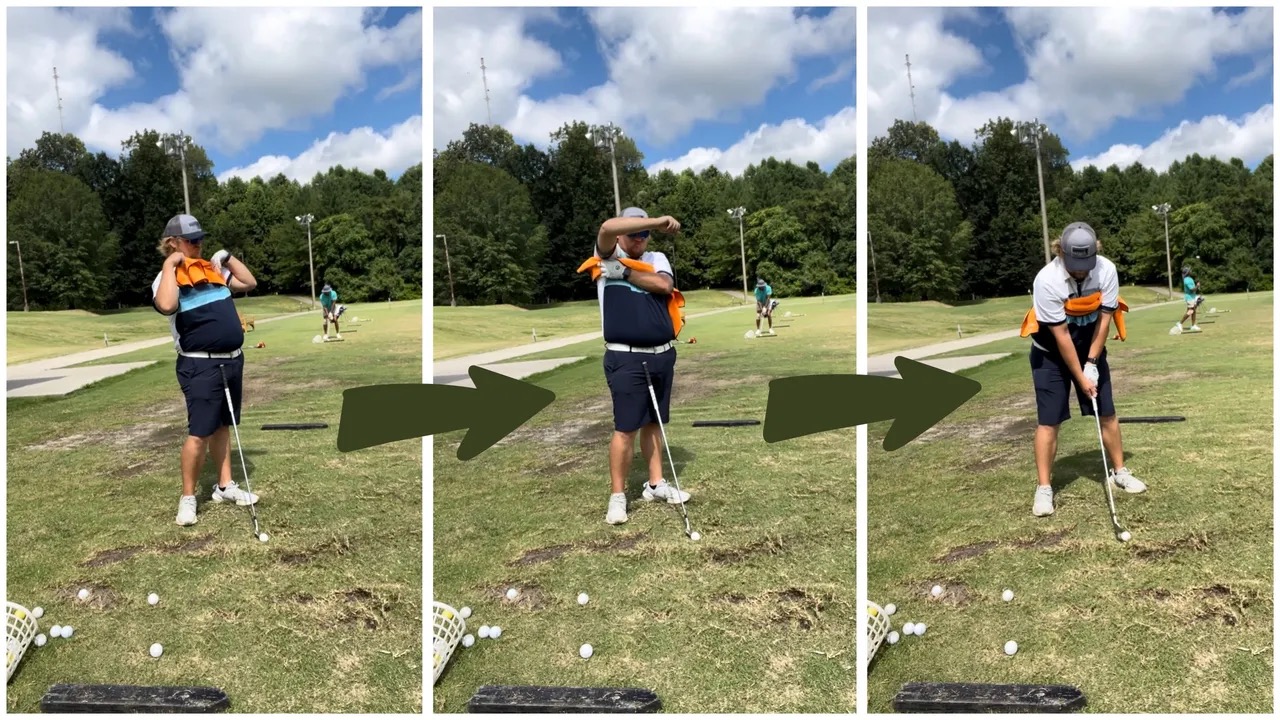
Get a Better Shoulder Turn
Many of us struggle to have proper shoulder rotation in our golf swing, especially during long layoffs. Making a swing that is all arms and no shoulders is a surefire way to have less control with wedges and less distance with full swings. Notice how I can get in a similar-looking position in both 60° wedge photos. However, one is weak and uncontrollable, while the other is strong and connected. One allows me to use my larger muscles to create my swing, and one doesn’t. The follow-through is another critical point where having a good connection, as well as solid shoulder rotation, is a must. This drill is great for those who tend to have a “chicken wing” form in their lead arm, which happens when it becomes separated from the body through impact.
In full swings, getting your shoulders to rotate in your golf swing is a great way to reinforce proper weight distribution. If your swing is all arms, it’s much harder to get your weight to naturally shift to the inside part of your trail foot in the backswing. Sure, you could make the mistake of “sliding” to get weight on your back foot, but that doesn’t fix the issue. You must turn into your trial leg to generate power. Additionally, look at the difference in separation between my hands and my head in the 8-iron examples. The green picture has more separation and has my hands lower. This will help me lessen my angle of attack and make it easier to hit the inside part of the golf ball, rather than the over-the-top move that the other picture produces.
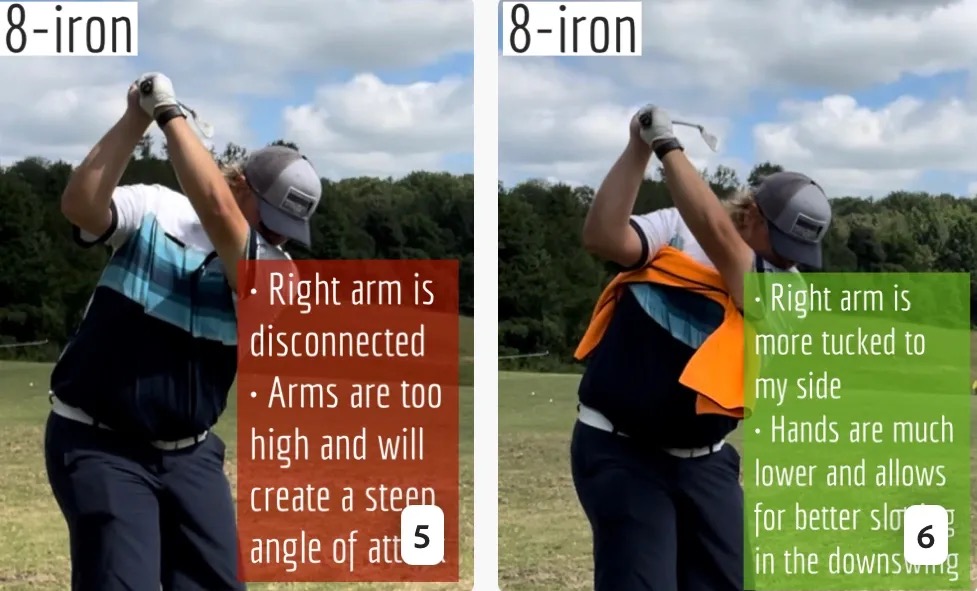
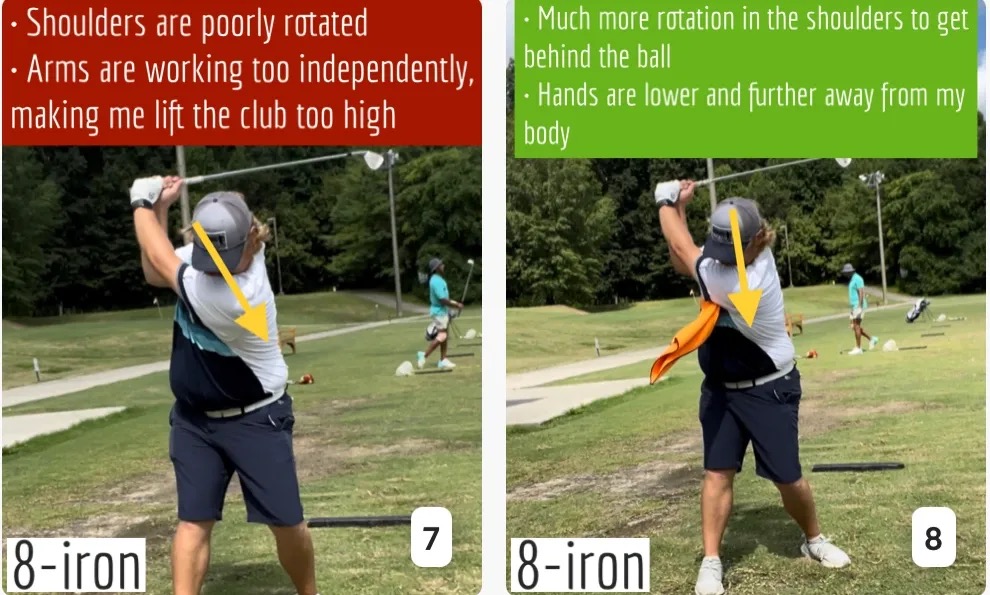
Stay Better Connected in the Backswing
When you don’t keep everything in your upper body working as one, getting to a good spot at the top of your swing is very hard to do. It would take impeccable timing along with great hand-eye coordination to hit quality shots with any sort of regularity if the arms are working separately from the body.
Notice in the red pictures of both my 60-degree wedge and 8-iron how high my hands are and the fact you can clearly see my shoulder through the gap in my arms. That has happened because the right arm, just above my elbow, has become totally disconnected from my body. That separation causes me to lift my hands as well as lose some of the extension in my left arm. This has been corrected in the green pictures by using this drill to reinforce that connection. It will also make you focus on keeping the lead arm close to your body as well. Because the moment either one loses that relationship, the towel falls.
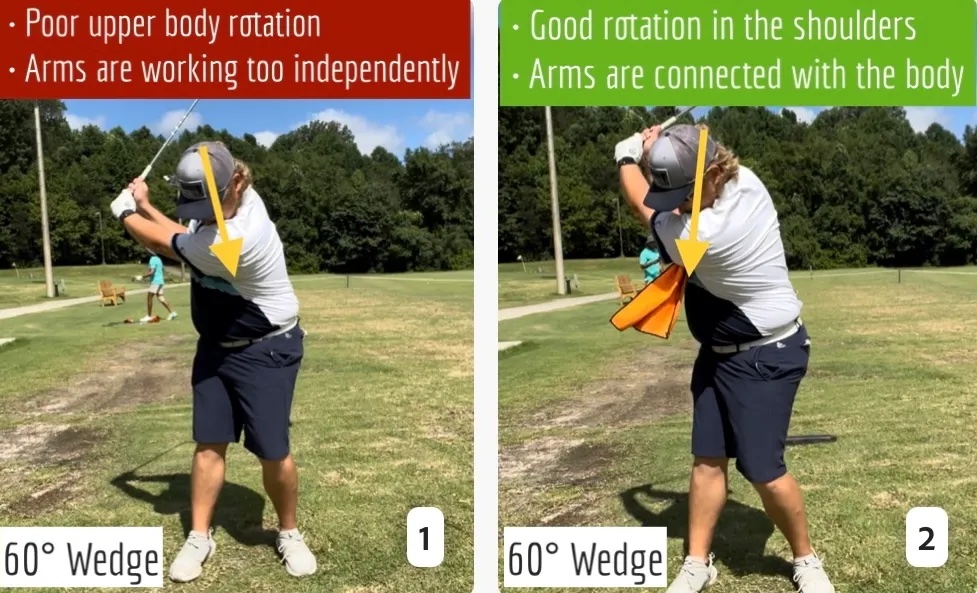
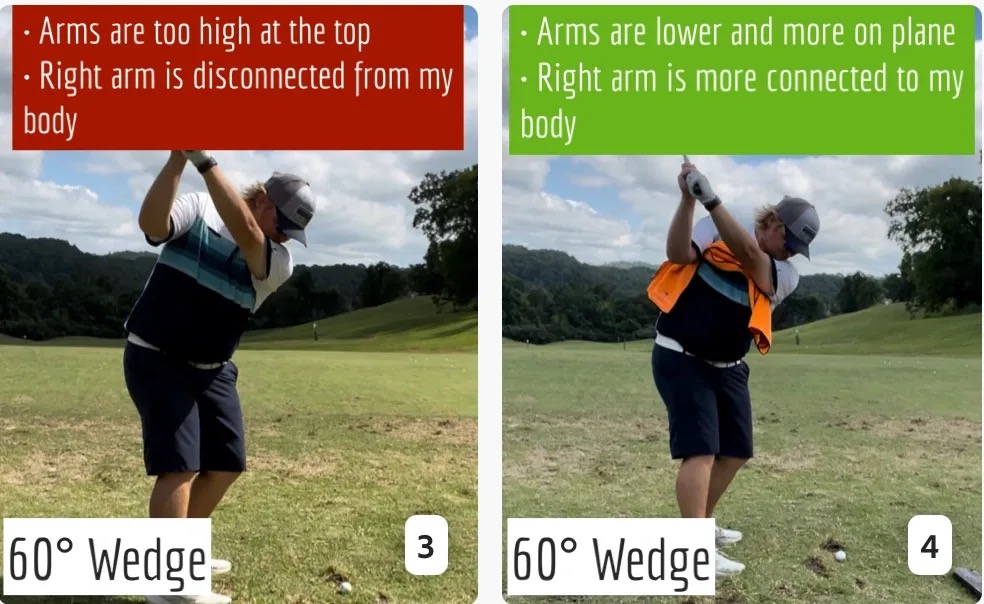
Conclusion
I have been diligent this year in finding a few drills that target some of the issues that plague my golf game; either by simply forgetting fundamental things or by coming to terms with the faults that have bitten me my whole career. I have found that having a few drills to fall back on to reinforce certain feelings helps me find my game a little easier, and the “towel drill” is most definitely one of them.
- LIKE12
- LEGIT2
- WOW2
- LOL0
- IDHT0
- FLOP2
- OB0
- SHANK8
-

 19th Hole6 days ago
19th Hole6 days agoDave Portnoy places monstrous outright bet for the 2024 Masters
-

 19th Hole2 weeks ago
19th Hole2 weeks agoThings got heated at the Houston Open between Tony Finau and Alejandro Tosti. Here’s why
-

 19th Hole1 week ago
19th Hole1 week agoTiger Woods arrives at 2024 Masters equipped with a putter that may surprise you
-

 19th Hole2 weeks ago
19th Hole2 weeks agoReport: Tiger Woods has ‘eliminated sex’ in preparation for the 2024 Masters
-

 19th Hole2 days ago
19th Hole2 days agoTwo star names reportedly blanked Jon Rahm all week at the Masters
-

 19th Hole2 days ago
19th Hole2 days agoNeal Shipley presser ends in awkward fashion after reporter claims Tiger handed him note on 8th fairway
-

 19th Hole2 weeks ago
19th Hole2 weeks agoAddiction, spinal fusion, and scam artists – Everything Anthony Kim revealed in candid interview with David Feherty
-

 19th Hole2 weeks ago
19th Hole2 weeks agoAnthony Kim says doctors told him that he ‘may not have much time left’ ahead of LIV return














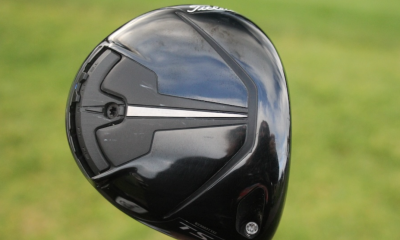



TC
Jul 11, 2017 at 9:53 am
This is something I used to do naturally. I’d definitely like to note that there is a fine line between this “side bend” in the take away, and bending towards the target line, and if your hips are off a little bit, you will rotate too laterally behind the ball. Much of this also comes to loading and keeping more weight on the lead foot in the golf swing, which last time I checked, was something that Sergio was known to do. It’s also the way I’ve gotten the most consistent results in my swing too, granted I’m certainly no major champion, it worked. Not quite stack and tilt, but favoring the lead side. Those two combinations gave me more power and consistency
Also, as Darrell said, it’s hard on your back to bend one way and twist another, etc. Proper posture will certainly help, but the spine can, and will only handle so much, no matter how fit you are. I wouldn’t say this posture equates to certain death to your spine, but it is a swing technique that I did notice causing a bit more strain on the spine than some others, but not necessarily enough to steer someone away from trying it. I think the results are really good, and after moving away from it for a short time, I’m working my way back into it now.
Dave R
Jul 11, 2017 at 12:27 am
Yep
Darrell Klassen
Jul 10, 2017 at 6:41 pm
The move, as explained here, it what screwed up Colin Montgomery’s back.
Darrell Klassen
Jul 10, 2017 at 6:38 pm
I don’t stick my nose in, usually, but the move as explained here is what screwed up Colin Montgomery’s back.